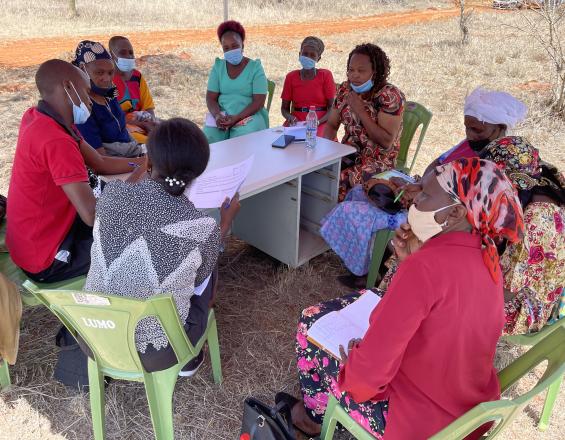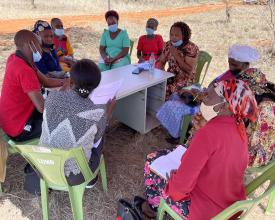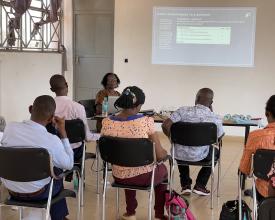Assessment of Governance and Equity of Lumo and Satao Elerai Conservancies for improved conservation and development outcomes (Avaliação da governança e da equidade das áreas de conservação de Lumo e Satao Elerai para melhorar os resultados de conserva...

As áreas de conservação da vida selvagem no Quênia enfrentam vários desafios relacionados à governança, como preconceitos contra mulheres e jovens, falta de reconhecimento e respeito pelos direitos de todos os atores relevantes, falta de participação plena e efetiva de todos os atores relevantes na tomada de decisões, falta de transparência, compartilhamento de informações e responsabilidade por parte das autoridades e falta de compartilhamento equitativo de benefícios. A Kenya Wildlife Conservancies Association (KWCA) priorizou a avaliação da governança e da equidade entre as unidades de conservação membros com o objetivo de identificar e implementar ações para a conservação eficaz da biodiversidade e melhores meios de subsistência para as comunidades. Em 2021, a KWCA, com o apoio dos Pequenos Subsídios Técnicos para Avaliação da BIOPAMA, apoiou a implantação da ferramenta SAGE na Lumo Community Wildlife Conservancy e na Satao Elerai Conservancy para identificar e priorizar ações de fortalecimento da governança e da equidade para melhorar a biodiversidade e os resultados sociais.
Contexto
Desafios enfrentados
Social
- Exclusão de mulheres e jovens nos processos de gestão e tomada de decisões de conservação
Desafios econômicos
- Arranjos pouco claros de compartilhamento de benefícios dentro das áreas de conservação
- Falta de oportunidades alternativas de renda
Ambientais
- Aumento das incidências de caça ilegal, especialmente de carne de animais selvagens, devido à interrupção dos meios de subsistência pela COVID-19
- Sobrepastoreio dentro das áreas de conservação devido a práticas de pastoreio não planejadas
Localização
Processar
Resumo do processo
Os blocos de construção estavam intimamente ligados e se complementavam para proporcionar um processo SAGE bem-sucedido. A comunicação eficaz foi fundamental na co-identificação e no envolvimento das partes interessadas no escopo do projeto, bem como na criação de conscientização e no treinamento das partes interessadas na ferramenta e nos processos do SAGE.
Blocos de construção
Engajamento das partes interessadas
A Avaliação SAGE é um processo participativo que envolve todas as principais partes interessadas da área de conservação. A identificação das partes interessadas foi realizada na fase de planejamento da avaliação. Esse mapeamento das partes interessadas foi liderado pelo consultor do SAGE e envolveu a Kenya Wildlife Conservancies Association (KWCA), a Taita Taveta Wildlife Conservancies Association (Associação de nível de paisagem da KWCA que trabalha na paisagem de Tsavo) e a Amboseli Ecosystem Trust (Associação de nível de paisagem da KWCA que trabalha na paisagem de Amboseli). Os seguintes grupos de partes interessadas foram identificados e convidados para os workshops de avaliação: Administração da conservação, investidores da conservação, jovens, homens, mulheres e diretoria. As avaliações contaram com a presença de um total de 99 participantes.
Cada avaliação foi seguida de um workshop de síntese, no qual cada grupo selecionou de dois a três representantes para participar do workshop de síntese. As conclusões dos workshops de avaliação foram apresentadas no workshop de síntese e ideias para ação foram discutidas. Um total de 46 partes interessadas de duas áreas de conservação participaram do workshop de síntese.
O envolvimento de todas as partes interessadas relevantes no SAGE garante que todas elas sejam ouvidas e investidas nas ações sobre as quais decidem coletivamente.
Fatores facilitadores
- A identificação colaborativa das partes interessadas possibilitou o mapeamento exaustivo de todas as principais partes interessadas
- O agrupamento das partes interessadas de acordo com o interesse comum criou espaços seguros para que todos (especialmente mulheres e jovens) pudessem dialogar de forma aberta e produtiva sobre o status de governança das áreas de conservação.
- O caráter de autoavaliação da ferramenta SAGE promoveu a apropriação do processo pela comunidade e as ações identificadas para implementação
Lição aprendida
- O envolvimento eficaz das partes interessadas desempenha um papel fundamental para garantir o entendimento compartilhado do escopo do projeto, bem como para promover uma abordagem colaborativa para a implementação do projeto.
- Agrupar as partes interessadas de acordo com os interesses é um ingrediente fundamental para discussões irrestritas e produtivas, especialmente por aqueles que podem ser marginalizados em termos de governança e processos de tomada de decisão.
- O engajamento eficaz dos participantes aumenta a propriedade dos processos e produtos de implementação do projeto
Treinamento na ferramenta SAGE
O SAGE é uma ferramenta relativamente nova para a avaliação da governança e da equidade no Quênia. O sucesso da implementação depende, portanto, do entendimento das partes interessadas sobre a ferramenta, seu escopo e aplicação. A KWCA recrutou um facilitador SAGE treinado e certificado que liderou a conscientização sobre a ferramenta para as principais partes interessadas, incluindo a KWCA, os gerentes das duas áreas de conservação e os representantes da Landscape Association.
A ferramenta SAGE prevê o recrutamento de facilitadores assistentes para apoiar a facilitação do SAGE e a tomada de notas. No total, 22 cofacilitadores e anotadores foram recrutados, treinados e enviados para apoiar a avaliação e o workshop de síntese. Seu treinamento concentrou-se em compreender a ferramenta SAGE, os vários princípios e as perguntas, bem como as habilidades básicas de facilitação.
Fatores facilitadores
- Recrutamento e contratação de um facilitador líder certificado do SAGE para liderar o processo
- A flexibilização das restrições de movimento devido à COVID-19 permitiu que a equipe de implementação do projeto viajasse e realizasse o treinamento de facilitadores assistentes no local
- A identificação participativa e o recrutamento de facilitadores assistentes garantiram o recrutamento bem-sucedido de talentos adequados para apoiar o processo.
Lição aprendida
- Os facilitadores assistentes do SAGE desempenham um papel fundamental de apoio na implementação do SAGE
- Por ser uma ferramenta nova no país, há necessidade de aumentar o treinamento dos facilitadores líderes do SAGE para ampliar a implementação do SAGE no país
Comunicação eficaz
A comunicação desempenhou um papel fundamental no sucesso desse projeto. A KWCA realizou várias reuniões virtuais desde os estágios de planejamento até o estágio de avaliação. A escolha de reuniões virtuais foi necessária devido à pandemia de covid-19 e às medidas governamentais associadas para controlar sua disseminação, incluindo o bloqueio do país, interrompendo assim a mobilidade e as reuniões físicas. Algumas das chamadas virtuais incluíram reuniões de planejamento, reunião inicial com os membros da conservação para melhorar o entendimento compartilhado do escopo do projeto e gerenciar as expectativas das partes interessadas. Também foram realizadas reuniões virtuais para conscientizar as principais partes interessadas sobre o SAGE e para mapear de forma colaborativa as partes interessadas da conservação.
O consultor-chefe, com o apoio dos facilitadores assistentes, liderou a tradução dos princípios e das perguntas do SAGE para o idioma local, a fim de ampliar a aceitação, especialmente pelas partes interessadas que só dominavam o idioma local.
Fatores facilitadores
- A tradução da ferramenta para o idioma local possibilitou uma participação mais ampla
- O recrutamento de facilitadores assistentes das comunidades locais e que dominavam os idiomas locais proporcionou oportunidades para a participação produtiva das partes interessadas, especialmente dos membros da conservação.
Lição aprendida
- A tradução da ferramenta para o idioma local possibilitou uma participação mais ampla
- A comunicação eficaz é fundamental para promover um entendimento compartilhado do escopo do projeto, além de garantir a implementação bem-sucedida do projeto
- O uso do idioma local é uma estratégia eficaz para garantir a participação e a adesão locais abrangentes, especialmente quando o público-alvo domina apenas os idiomas locais.
Impactos
- Apesar de o projeto ter sido implementado durante a pandemia da COVID-19, conseguimos concluir com êxito todas as atividades planejadas dentro do prazo do projeto. Essas atividades incluíram análise das partes interessadas, treinamento de facilitadores, avaliação do SAGE, workshop de síntese do SAGE e desenvolvimento de ações para implementação
- O projeto atingiu diretamente mais participantes (145) do que o planejado inicialmente (60).
- A Satao Elerai Conservancy incluiu jovens e mulheres nos processos de tomada de decisão da conservação. Um representante dos jovens foi incluído no comitê de conservação e as mulheres agora são consultadas nos processos de tomada de decisão da conservação, inclusive nas reuniões de conservação.
- Oza, uma fazenda constituinte da Lumo conservancy, agora inclui jovens e mulheres em seus conselhos.
- O caráter participativo e de autoavaliação do processo SAGE possibilitou que todas as partes interessadas, inclusive mulheres e jovens, participassem dos processos de tomada de decisão das unidades de conservação.
Beneficiários
- Membros da associação, incluindo mulheres, homens e jovens
- Diretoria e gerência da unidade de conservação
- Facilitadores assistentes do SAGE provenientes das áreas de conservação
- Investidores privados nas duas áreas de conservação
- ONGs de conservação que trabalham com as duas áreas de conservação

